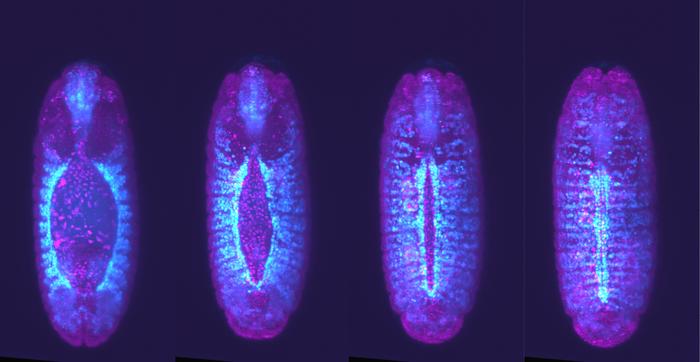In the intricate development of an embryo, one organ stands out for its life-sustaining importance: the heart. New research published on March 12, 2025, in the Biophysical Journal has shed light on how heart cells navigate their surroundings to achieve a precise alignment necessary for proper organ formation. Researchers have discovered that the process resembles a form of matchmaking, where each cell must find its perfect partner to ensure the heart develops correctly. The heart’s development is a marvel of nature, characterized by close collaboration among various cell types, each with distinct roles and identities.
At the very beginning of heart development, cells arise from two separate regions of the embryo. These cells initially exist far apart but are gradually guided toward each other as development progresses. They are set on a journey fraught with challenges, as any misalignment during this critical time can severely impact the heart’s ability to function. This research reveals how these embryonic heart cells employ a dynamic ‘speed dating’ technique, where they rapidly probe and evaluate potential partners in a race against time to achieve the right arrangement.
The lead author of the study, Timothy Saunders from the University of Warwick, articulates that the behavior of these heart cells is akin to socializing at a crowded venue. “As the cells come together, they jiggle and adjust, and somehow always end up pairing with a heart cell of the same type,” he explains. This remarkable capacity for self-organization is not merely chance but a finely tuned biological process that hinges on several critical mechanisms.
Central to this matchmaking process is the presence of tentacle-like structures known as filopodia. These extensions allow the heart cells to reach out and grasp potential partners, initiating connections that lead to eventual alignment. Previous studies by Saunders indicated that certain proteins create waves that serve to separate incompatible cell types, providing each cell a renewed opportunity to connect with the right match. This elaborate dance between cells ensures that partnerships form correctly, minimizing the risk of developmental mishaps.
The researchers’ model suggests that heart cells naturally gravitate toward a state of ‘energy equilibrium.’ This state is reminiscent of physics principles, where systems tend toward stability to minimize energy. In this context, heart cells exhibit similar behavior as they strive to balance the competing forces of connection and the inherent ability to adjust to mechanical strains—the two key factors in creating a resilient and functional heart. The model developed by the researchers not only demystifies this intricate process but also provides a mathematical framework to predict cell behavior.
The implications of this research extend beyond just heart health; they touch upon various biological processes where cell alignment is crucial. For instance, similar mechanisms are implicated in neuronal connections, wound healing, and facial development. Misalignments during these processes can result in serious congenital conditions like cleft lip or other anomalies. As such, understanding the principles of cellular matchmaking offers valuable insights that can have far-reaching applications in developmental biology and medicine.
To validate their proposed model, the team conducted experiments on heart cells in fruit flies, introducing mutations and observing misalignments. By analyzing the adhesive energy between different cell types and evaluating tissue elasticity, they found that their model accurately predicted how the cells would rearrange themselves. “Occasionally, the heart tube ends up with a mismatch, such as one cell on one side when there should be two,” Saunders notes. By inputting these imperfections into their model, the outcomes closely aligned with actual embryonic observations, reinforcing the model’s reliability.
Moreover, this research not only provides a deeper understanding of how intricate biological alignment occurs but also opens avenues for exploring therapeutic interventions. With an enhanced grasp of these fundamental processes, scientists can potentially devise strategies to correct or prevent developmental issues arising from miscommunication between cells during critical periods in embryo formation.
The study’s findings emphasize the significance of fundamental biological principles that govern cell behavior during heart development. As the researchers highlight, by quantifying these processes, they can begin to construct a more detailed understanding of embryonic development. Such insights may serve as a basis for future studies aimed at enhancing medical interventions for congenital heart defects, one of the most prevalent types of birth defects globally.
In conclusion, this transformative research underscores not only the complexity of embryonic development but also the elegance with which nature orchestrates cellular interactions. The heart, as a vital organ, relies on the precise coordination of its constituent cells to form a functional entity. As this new study illuminates, understanding these processes is crucial for advancing the fields of developmental biology and regenerative medicine. By unlocking the secrets of cellular matchmaking, we move closer to improving health outcomes for individuals affected by heart defects and other related conditions.
Subject of Research: Cells
Article Title: Interfacial energy constraints are sufficient to align cells over large distances
News Publication Date: 12-Mar-2025
Web References: Biophysical Journal
References: 10.1016/j.bpj.2025.02.011
Image Credits: Credit: Thamarailingam Athilingam and Kate McDole
Keywords
/ Life sciences / Developmental biology / Ontogeny / Human development
/ Life sciences / Computational biology / Biological models
/ Life sciences / Cell biology / Cellular physiology / Cell development
/ Life sciences / Organismal biology / Anatomy / Nervous system / Nerve tissue
/ Physical sciences / Physics / Chemical physics / Molecular physics
/ Physical sciences / Chemistry / Chemical biology
Tags: Biophysical Journal findings on tissue developmentcell communication during heart developmentchallenges in embryonic organ developmentdynamic behavior of heart cellsembryo development and organ formationembryonic heart cell alignment mechanismsimportance of cell type collaborationmatchmaking process in heart cell developmentresearch on heart development mechanismsrole of heart cells in embryogenesisspeed dating analogy in cell behaviortissue formation and cellular interaction





